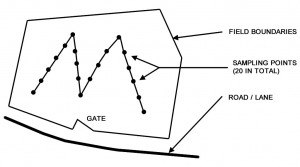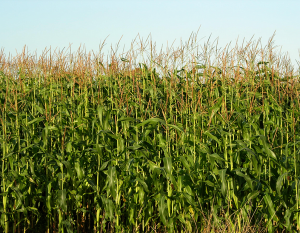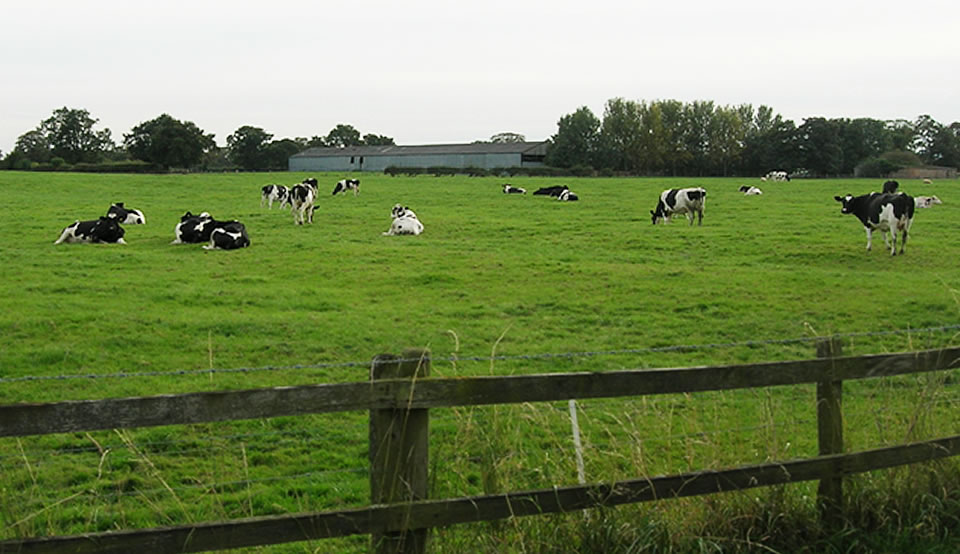Download pdf: Planning potash applications (222.96K)
pdf 222.96K
Planning potash applications
August 2015
As growers and advisers we need to know how much potash we should apply to ensure crops thrive in terms of yield and quality. Previous articles have described the way soils hold potash and how the plants use it. This article takes us on to the reality of deciding how much, and when to apply potash. It will run through the process of making a recommendation and comment on relevant issues. The standard reference for this aspect of Potash agronomy is The Fertiliser Manual – RB209, which provides the recommendations for most crops (including grass). It also includes data on the typical nutrient content of organic manures, which are a useful potash source, along with the usual fertilisers. Although this article is about potash, the principles are similar for phosphate, excepting where phosphate responsive crops, such as potatoes, are grown.
Rate Required
 The nutrient planning process starts by needing to know how much potash the soil contains, so prior soil sampling is the first stage, and should be carried out routinely for each field, typically every 4 years. It is essential that this sampling is carried out correctly to achieve a “truly representative sample” for the field. All fields have some variation in P and K levels due to changes in soil texture/depth, and areas of higher or lower yields. Areas may also vary because of uneven applications of fertilisers or manures in previous years. We need a good average result on which to base our decisions, so there is an important protocol to follow which is outlined in RB209 for normal sampling. Where Precision Farming techniques, such as variable rate applications, are to be undertaken, then more accurate sampling is done, for example, based on 1 hectare grids, or soil zones.
The nutrient planning process starts by needing to know how much potash the soil contains, so prior soil sampling is the first stage, and should be carried out routinely for each field, typically every 4 years. It is essential that this sampling is carried out correctly to achieve a “truly representative sample” for the field. All fields have some variation in P and K levels due to changes in soil texture/depth, and areas of higher or lower yields. Areas may also vary because of uneven applications of fertilisers or manures in previous years. We need a good average result on which to base our decisions, so there is an important protocol to follow which is outlined in RB209 for normal sampling. Where Precision Farming techniques, such as variable rate applications, are to be undertaken, then more accurate sampling is done, for example, based on 1 hectare grids, or soil zones.
Soil analysis is carried out by the laboratories who follow a set standard for the process. They will measure the “exchangeable” potassium in the soil, which is the “available” part, which we can rely on for growing our crops. Their analytical result (eg. mg/l) is then converted into an index (0,1,2,3 etc) for the purpose of making recommendations. The indices have been defined (using much trials data, over a lot of years and crops) so that we can categorise our soils for potash. The index system also prevents us assessing the lab result more accurately than the accuracy of our sampling regime warrants.
The soil indices have been set to tell us the safe level of K at which we should operate, so that the yield will not be hindered. It is vitally important that a lack of potash does not diminish the crop’s ability to respond to nitrogen. It is also important that there is enough potash available to satisfy the peak uptake by the crop. This is often very high, even if only temporarily, and occurs at flowering.
This target index for K is 2- (P=2) and the potash policy should be to “maintain” this level in the field for future crop years. As crops are harvested and removed from the field, so potash is taken away in that crop material. This must be replaced otherwise future crops will be grown in soil with a reduced potash level, and lower yields will then occur. Accordingly, recommendations at target index are set to maintain the concentration of K in the soil, and will therefore equal the amount removed in the harvested crop, the so-called “crop offtake”. This means that the yield must be predicted, using local knowledge, and for cereals and oilseed rape, the fate of the straw must also be predicted. There is a lot of potash in straw, so the offtake values vary according to whether the straw is to be baled and removed from the field, or incorporated back into the soil. If, at harvest, the plan for straw or yields vary significantly, then compensating adjustments can be made in the following year.
Where the soil analysis gives a lower index (0 or 1), we can expect to get lower yields (trials data prove this), and hence we need to build the soil up to target index to reduce this problem in future years. To achieve this, the maintenance amount is needed plus extra to build the K index. The amount needed is substantial and varies by soil type. It is best to achieve the build by using extra potash, each year for several years, until routine soil analysis shows the target index has been reached. In RB209 for grass and arable cropping, the recommendation tables use build rates which will take 10-15 years to raise the index by 1. An alternative approach is to speed up the build by applying larger amounts each year.
 This build process obviously incurs considerable extra expense and is not specifically for the sake of the crop to be grown in that year. Hence the cost of the build element in the total recommendation should be borne by the farm overhead costs, as part of putting the land into good condition, as we do for drainage and liming.The PDA PK Calculator on our website (www.pda.org.uk) helps with this by calculating the annual build amount according to how many years you plan to take to get to target index, and it shows the maintenance amount for the crop being planned. In reality, one would never try to do the build in one year, as some would be transformed into relatively unavailable forms, which is less efficient. More usually one would take 4 or 5 years.
This build process obviously incurs considerable extra expense and is not specifically for the sake of the crop to be grown in that year. Hence the cost of the build element in the total recommendation should be borne by the farm overhead costs, as part of putting the land into good condition, as we do for drainage and liming.The PDA PK Calculator on our website (www.pda.org.uk) helps with this by calculating the annual build amount according to how many years you plan to take to get to target index, and it shows the maintenance amount for the crop being planned. In reality, one would never try to do the build in one year, as some would be transformed into relatively unavailable forms, which is less efficient. More usually one would take 4 or 5 years.
Where the soil analysis gives a higher index than target (eg. K 2+, P 3), then less than maintenance can be applied, and crop offtakes will run down the K over a period of years. RB209 tables suggest a steady rundown process, and take some years over it, which is the “safe” way. However the temptation may be to cut out the application for several years, and this may be acceptable, but it is very important to follow its progress carefully by soil sampling more frequently. Be warned, indices do seem to fall much quicker than they rise!
Finally, a comment on potash recommendations for grass for silage. As we cut grass for silage at its peak potash content (start of flowering), huge amounts of potash are removed from the field, and the maintenance recommendation is very high. Economically, this means we should try to get the slurry/manure produced when the silage is eaten, spread back on the silage fields, as part of their potash recommendation.
Timing of Application
The general rule for arable crops is that where the soil is at target index (K = 2-) the application timing is unimportant to the crop being grown, because the policy is simply replacing expected crop offtake, for the benefit of future crops. Traditionally potash (and phosphate) are applied to the soil prior to planting the crop. This guarantees an easy supply for the seedlings and is useful because the cultivations mix the fertiliser in the soil. Usually, nowadays on cereals and oilseed rape, the potash is applied at any time to suit the farm workload, and may well be done in the winter “on the frost”.
However in sensitive situations, things are different and timing does matter. If the soil is low in K (index 0 or 1), then application prior to planting is required to assist the seedlings. If very low (K = 0), then much larger amounts are needed and so the dressings are split into two applications – prior to (or at) planting, followed by top dressing, usually with the spring nitrogen application. On very light soils, with their inherently poor ability to hold K, multiple potash top dressings are helpful.
Where grass seeds are being established, potash is applied prior to planting. The mixing process of cultivation is even more valuable as it evens out the potash in the top few inches of soil with the layers below – a rare chance in grassland which is not planted every year.
For silage grass, where large amounts are required due to the high offtakes, then split applications are needed. An early dose in the Spring, followed by dressings after each cut are required. This means that we do not apply very high rates each time and this reduces the risk of excessive uptake by the grass, so-called “luxury uptake”. Sometimes this system will require an autumn application to get the final amount on. Where slurry is used to supply some of the potash requirement, it is best applied in early spring as soon as ground conditions for spreading allow. On some soils and in wetter regions, this may not be until after 1st cut.
Grazing grass only requires a potash application where the soil index is below target (i.e. K = 0 or 1). This recommendation is to build it up over several years. Such applications are made in mid season (e.g. June) when grass growth has slowed up, or in the autumn. These timings are designed to reduce the risk of high uptakes of potash by the grass, which can encourage magnesium deficiency (grass staggers) in the grazing animals. The offtake of potash in animal products (milk, meat) is insignificant, so at target index maintenance dressings are not needed. If the grazing animals are fed concentrates, or bought in forage, then some of the potash in them will be deposited on the soil via their manure, and K levels will rise.
For vegetables the target index is raised to K = 2+. This is often because these crops are poorer rooted and have to grow very quickly. However they still need high levels of potash (peak uptake) for their development and high yields. Accordingly, application of the potash fertiliser at planting is usually beneficial. Some growers may choose to include potatoes in this vegetable category.


